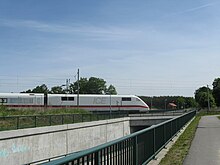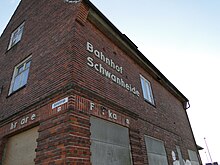Schwanheide station
| Schwanheide | |
|---|---|
|
Schwanheide stop (2008)
with the station building demolished in 2012 |
|
| Data | |
| Operating point type | Stop ( stop and transfer point ) |
| Platform tracks | 2 |
| abbreviation | WSAH |
| IBNR | 8012933 |
| Price range | 6th |
| opening | December 1, 1886 |
| Profile on Bahnhof.de | Schwanheide |
| location | |
| City / municipality | Schwanheide |
| country | Mecklenburg-Western Pomerania |
| Country | Germany |
| Coordinates | 53 ° 25 '40 " N , 10 ° 41' 25" E |
| Height ( SO ) | 18 m above sea level NHN |
| Railway lines | |
|
|
| Railway stations in Mecklenburg-Western Pomerania | |
The Schwanheide station was during the division of Germany , a border station in the course of the Berlin-Hamburg Railway on the side of the German Democratic Republic in Mecklenburg place Schwanheide . With the expansion of the Berlin – Hamburg railway line as part of the German Unity transport project , the former train station became a stop .
history
The Schwanheide stop was opened on December 1, 1886. Originally the station was used exclusively for passenger traffic. From May 1, 1908, the station was also used for freight traffic and was equipped with a loading ramp.
After the end of the Second World War , the Berlin – Hamburg line between Schwanheide and Büchen was divided by the inner-German border . On the east side, one of the two main lines between Berlin and Schwanheide was dismantled as reparation ; On the West German side, too, the second track between the Büchen border station and Schwarzenbek was removed .
Traffic in the area of the demarcation line was initially completely interrupted, especially since the bridges over the Elbe-Lübeck Canal near Büchen were also destroyed. The bridge was restored in the summer of 1946, but freight traffic did not resume until August 27, 1947. Initially, a pair of passenger trains was also envisaged in the negotiations, but this was not introduced. Initially, there were three through freight trains per day and one handover between Büchen and Schwanheide and, if necessary, a local freight train to Boizenburg . Additional freight trains were agreed in the autumn of the same year. During the Berlin blockade in 1948, traffic decreased significantly, but did not come to a complete standstill. Passenger traffic was resumed on September 10, 1949, initially with a steam locomotive-hauled pair of trains and a Cologne-type express multiple unit , which was also known as the "Flying Hamburger" because of its similarity.
After the cross-border train service between Herrnburg and Lübeck was discontinued in 1952 ( railway line Bad Kleinen – Lübeck , resumption in 1960), in 1953 ten regular and three demand goods trains ran westwards and five regular and three demand goods trains in the opposite direction. In 1953, a barrack was set up on platform 1 for transit handling and a second track and a central platform were set up; later tracks 3 and 4 followed.
From 1965, freight trains were also in transit to and from West Berlin via Schwanheide. However, the track capacities in Schwanheide were insufficient to control passenger and freight trains there. Therefore, freight trains were dispatched at Kuhlenfeld station, 18 kilometers from the border . Before a freight train left the Kuhlenfeld wagon border point, it had to be ensured that the train could pass Boizenburg without stopping and Schwanheide could pick it up. Stops en route led to another inspection in Schwanheide, which led to delays in other train traffic.
At the beginning of the 1980s, a new terminal building was built on the south side of the station. After the political change , long-distance trains no longer stopped in Schwanheide from September 30, 1990. With the expansion of the line as part of the German Unity transport project , the Hagenow Land - Büchen section via Schwanheide was electrified in 1996 , the track layout was reduced to two through tracks and the station became a stop. In the course of a further extension of the route to a maximum speed of 230 km / h, the level crossing directly west of the station was replaced by an underpass in 2004/2005 .
Railway and border control facilities
Anyone traveling to Schwanheide on the trains of the GDR internal traffic required a pass or a passport for the onward journey to the Federal Republic. Railway employees had to exchange their passes for special ID cards during their work stay at the station so that the passport control unit had an overview of the people present. Trains in the direction of Schwanheide were already checked by the transport police from the Hagenow Land station . Travelers to the town of Boizenburg, which is outside the restricted border area, were also asked about the reasons for traveling there.
The station itself was equipped with five tracks in the 1980s. Track 1 was at the border clearance building and Mitropa , tracks 2 and 3 were on a central platform, track 4 and a shortened fifth platform were at the station building on the north side, where the mechanical signal box B 2 was also located. A second mechanical signal box W 1 was located at the east end of the station. On both sides of the station, the tracks were spanned by post bridges, from which border troops watched trains entering and leaving . The supervisor was on the central platform.
The station area was fenced in except for the track entrances and was lit up as bright as day at night. The track branching off from track 3 was intended for trains ending in Schwanheide.
A passage without stopping or the following of a second train on a train already driving towards the border was made impossible by technical protection devices such as turnouts ending in the gravel bed. In addition to passport and baggage controls, sharp dogs were used against refugees. Train reports from the railway staff to Büchen were recorded and could be checked and evaluated by the safety authorities. If there were graffiti on an arriving freight train from Büchen, such as swastikas or anti-GDR slogans, these were removed or painted over in Schwanheide if necessary.
Todays situation
Only trains on the RE 1 Hamburg – Schwerin – Rostock regional express line stop in Schwanheide . The railway line has been developed for speeds of up to 230 km / h. Long-distance trains pass the stopping point at high speed, which is why the platforms are secured by barriers and warning signs. The border clearance building is empty and exposed to vandalism. In 2012 the station building on the north side, which was also empty, was demolished.
| line | route | Tact |
|---|---|---|
| RE 1 | Hamburg - Büchen - Schwanheide - Hagenow Land - Schwerin - Bad Kleinen - Blankenberg - Rostock | Every two hours with amplifiers |
Web links
Individual evidence
- ↑ Dietrich Kutschik, Burkhard Sprang: Die Berlin-Hamburger Eisenbahn , Transpress, Stuttgart 1996, ISBN 3-344-71040-0 , p. 56
- ↑ Traffic Atlas of Europe (Dr. W. Kochs Railway and Traffic Atlas of Europe) ed. by C. Opitz, Leipzig: Arnd, 1906
- ^ Peter Bley: 150 years of the Berlin-Hamburg railway , alba, 1996, ISBN 3-87094-229-0 , p. 107
- ^ Association of Central European Railway Administrations (ed.): Station directory of the railways of Europe (formerly Dr. Koch's station directory). Published by Barthol & Co., Berlin-Wilmersdorf 1939.
- ↑ a b Ralf Roman Rossberg , border on German rails, railway courier publishing house, Freiburg 1980, ISBN 3-88255-828-8 , pages 52-56
- ↑ a b c d e Norbert Weise: Schwanheide In: Erich Preuß (Ed.): The large archive of German train stations , GeraMond-Verlag, Munich 2006, ISSN 0949-2127
- ↑ Deutsche Bahn press release of November 22, 2004 on pressrelations.de, accessed on January 6, 2016
- ↑ Track plan of the Schwanheide station from 1982 on the homepage of Norbert Weise
- ↑ Grenzbahnhof Schwanheide on napoleon-web.de



